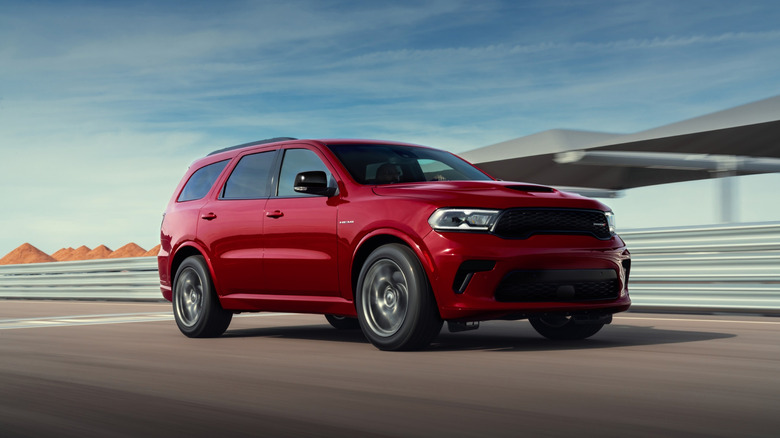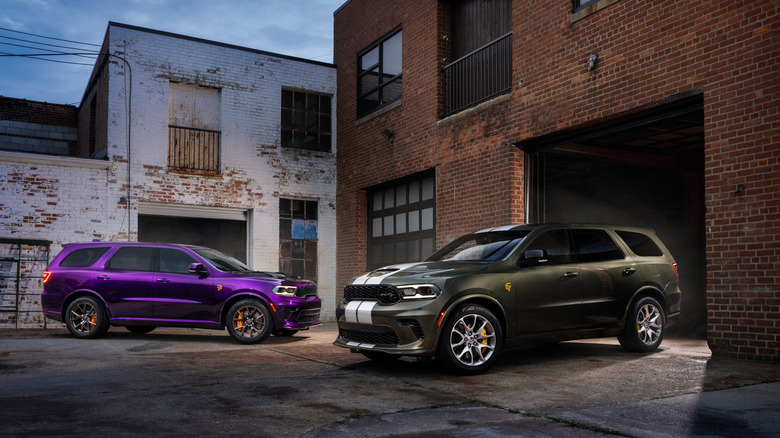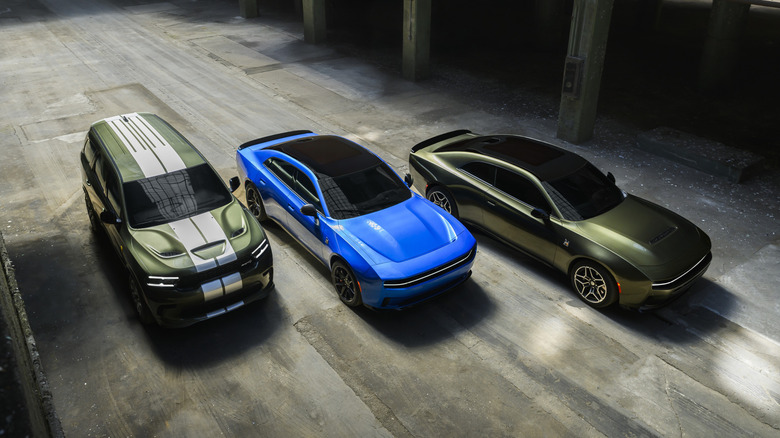The Durango Is Good For Muscle Fans, Bad For Dodge
Dodge's parent company Stellantis recently announced that the 2026 Dodge Durango will now come with a 5.7-liter Hemi V8 as its standard engine. It takes the place of the Pentastar V6, an engine that's seen a production run of over five million units since 2011. To be frank, this is pretty bizarre news to announce in 2025 and a puzzling decision for Dodge that might not bode well. On the consumer's end, however, getting access to a (relatively) affordable V8-powered muscle SUV is never a bad thing.
The 2026 Dodge Durango GT has 360 horsepower and starts at $42,495. Stellantis noted in a press release that this price makes the Durango the least expensive all-wheel drive V8-powered vehicle you can buy today, although there are less expensive V8-powered trucks on the market. For example, the 5.0-liter powered base model Ford F-150 XL starts for a touch less at $41,213, but for that price you're limited to a standard cab and two-wheel drive. In a world of hybrid powertrains, EVs, and more efficient SUVs like the 2026 Honda CR-V Trailsport Hybrid, using a V8 as the standard engine across the Durango line has positive and negative implications for the Dodge brand.
Here's what's good
Starting with the good news (at least for people who enjoy the musical genre "V8 Exhaust Sounds"), the 2026 Dodge Durango will probably make good use of that 5.7-liter Hemi V8. As stated above, it's one of the least expensive V8-powered passenger vehicles you can buy today that isn't a work truck. Further up in the model's price range, the Dodge Durango Hellcat continues to live up to its name. If you're willing to pay upwards of $80,000 you get a 6.2-liter supercharged V8 that puts out 710 horsepower. That figure is not only more than that of any other American SUV including the supercharged Cadillac Escalade V-Series, but also higher than some different SUVs from supercar manufacturers. The Lamborghini Urus S "only" makes 657 horsepower and the Durango is a formidable challenger to the 714 horsepower V12-powered Ferrari Purosangue.
The hybrid Lamborghini Urus SE produces more horsepower at 788 but also costs more than a quarter of a million dollars, making the $80k Dodge Durango Hellcat a bargain in comparison. A more logical competitor to the Dodge Durango GT is the current 2025 Chevy Tahoe; it makes only 355 horsepower from its 5.3-liter V8, but even a two-wheel drive Tahoe will cost you more than $60,000. Most SUVs in the Durango's class use efficient turbocharged four-cylinders, V6s, or hybrid drivetrains. A naturally aspirated, V8-powered SUV is enough of a unicorn these days that some happy owners might want to mount a horn where the Ram's head hood ornament used to go on Dodge trucks.
Why a V8-powered Durango might be a bad thing
Now here's the bad news. Although there's been no word of impending doom as of yet, it's not always a great sign when an automaker drops an engine in a move to standardize and simplify its lineup. Before the Journey went into the wild blue yonder after the 2020 model year, Dodge simplified the range, offering only two trims and a 2.4-liter four-banger.
While moving on from the Pentastar V6 is only a minor concern for Durango buyers it might signal a larger problem within Dodge, which has done almost nothing to modernize. The new inline-six powered Dodge Chargers are cool and all, but the Dodge lineup is a getting a little thin. The company offers the Durango, a couple versions of the Charger, and the oft-forgotten Hornet, a model that has been so unpopular that Dodge is still trying to sell 2024 leftovers. Among those offerings, only the Hornet is available as a hybrid. A lineup of four models isn't enough, and it's worse when only two of them have moved into the modern era of powertrains.
Big V8-powered SUVs always have a market, and simplifying its lineup is usually a good thing for automakers. But those factors might not be enough to save Dodge from being a victim of Stellantis' struggles. In the context of Dodge's dwindling lineup and Stellantis' July bankruptcy filing in China, it might be too little, too late for Dodge.


